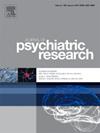Enriched environment mitigates anxiety and depression-like behaviors induced by SNI via restoration of AMPA and NMDA receptors function in mice
IF 3.7
2区 医学
Q1 PSYCHIATRY
引用次数: 0
Abstract
Background
Chronic pain is well-known for inducing anxiety and depression in humans. Enriched environment (EE) has shown promising effects in alleviating mood disorders; however, the precise mechanisms remain poorly understood. The medial prefrontal cortex (mPFC), a pivotal brain region associated with emotion regulation, particularly through excitatory synaptic transmission, is implicated in the processing of pain-related mood disorders.
Methods
First, adult male C57BL/6 mice 6 weeks after spared nerve injury surgery, were subjected to the behavioral tests and dendritic spine morphology staining. Then, 2 weeks after spared nerve injury (SNI), mice were housed in enriched environment, to establish model EE. Behavioral outcomes, dendritic spine maturation, and AMPA and NMDA receptors expression were assessed up to 4 weeks after EE treatment using behavioral tests, Golgi staining, Western blot, and pharmacological experiments.
Results
Our results showed that SNI mice exhibit anxiety and depression-like behaviors. Further analysis revealed that SNI mice displayed a significant reduction in mature dendritic spines in the mPFC. After 4 weeks of housekeeping in EE, dendritic complexity, spine maturity, and the expression of AMPAR and NMDAR of SNI mice were restored, leading to a rescue of anxiety and depression-like behaviors. Moreover, pharmacological antagonism of AMPAR or NMDAR, by intraperitoneal injection of AP-5 or CNQX, effectively abolished the alleviating effect of EE on anxiety and depression-like behaviors in SNI mice.
Conclusions
Together, our findings uncovered a previously unrecognized AMPAR and NMDAR-dependent mechanism of EE in mitigates anxiety and depression-like behaviors in SNI mice via restoration of mPFC excitatory synaptic transmission.
富集环境通过恢复小鼠AMPA和NMDA受体功能减轻SNI诱导的焦虑和抑郁样行为
众所周知,慢性疼痛会引起人类的焦虑和抑郁。强化环境(EE)在缓解情绪障碍方面显示出良好的效果;然而,确切的机制仍然知之甚少。内侧前额叶皮层(mPFC)是一个与情绪调节相关的关键大脑区域,特别是通过兴奋性突触传递,与疼痛相关的情绪障碍的处理有关。方法首先对成年雄性C57BL/6小鼠行神经损伤手术后6周的行为学测试和树突棘形态染色。然后,在SNI后2周,将小鼠置于富集环境中,建立模型EE。在EE治疗4周后,通过行为测试、高尔基染色、Western blot和药理学实验评估行为结果、树突棘成熟度、AMPA和NMDA受体表达。结果SNI小鼠表现出焦虑和抑郁样行为。进一步分析显示SNI小鼠mPFC中成熟树突棘明显减少。经过4周的EE整理,SNI小鼠的树突复杂性、脊柱成熟度、AMPAR和NMDAR的表达恢复,导致焦虑和抑郁样行为的恢复。此外,通过腹腔注射AP-5或CNQX对AMPAR或NMDAR的药理拮抗作用,有效地消除了EE对SNI小鼠焦虑和抑郁样行为的缓解作用。综上所述,我们的研究结果揭示了一种以前未被认识到的AMPAR和nmdar依赖的EE机制,通过恢复mPFC兴奋性突触传递来减轻SNI小鼠的焦虑和抑郁样行为。
本文章由计算机程序翻译,如有差异,请以英文原文为准。
求助全文
约1分钟内获得全文
求助全文
来源期刊

Journal of psychiatric research
医学-精神病学
CiteScore
7.30
自引率
2.10%
发文量
622
审稿时长
130 days
期刊介绍:
Founded in 1961 to report on the latest work in psychiatry and cognate disciplines, the Journal of Psychiatric Research is dedicated to innovative and timely studies of four important areas of research:
(1) clinical studies of all disciplines relating to psychiatric illness, as well as normal human behaviour, including biochemical, physiological, genetic, environmental, social, psychological and epidemiological factors;
(2) basic studies pertaining to psychiatry in such fields as neuropsychopharmacology, neuroendocrinology, electrophysiology, genetics, experimental psychology and epidemiology;
(3) the growing application of clinical laboratory techniques in psychiatry, including imagery and spectroscopy of the brain, molecular biology and computer sciences;
 求助内容:
求助内容: 应助结果提醒方式:
应助结果提醒方式:


